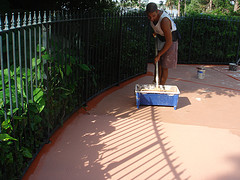Transform Your Patio with Paint
 Is your patio looking tired and dull? Why not give it a lift? Painting an outdoor floor a color you love ... or even adding a DIY brightly patterned “rug” right onto your patio surface ... is a fast and fairly inexpensive fix for a case of the decor doldrums. It’s easy to do, too – just follow these simple patio painting guidelines.
Is your patio looking tired and dull? Why not give it a lift? Painting an outdoor floor a color you love ... or even adding a DIY brightly patterned “rug” right onto your patio surface ... is a fast and fairly inexpensive fix for a case of the decor doldrums. It’s easy to do, too – just follow these simple patio painting guidelines.
Prepare the Area
Move your patio table and chairs safely out of the way. Make sure that children and pets will not have access to the patio until the paint job is complete and has had time to dry.
Clean first – get rid of dirt, debris, and stains. Remove mold or mildew (concrete, because it is a porous material, is susceptible to moisture and mold). Scrub or scrape off any wax build-up or peeling paint so that the new color will adhere and the completed patio will be smooth and even. However, if there is an existing coat of paint which is still sound, it does not need to be removed, but only cleaned. Pressure wash your patio floor and dry well.
To roughen the floor surface, etch it with muriatic (hydrochloric) acid. This will improve paint adhesion. CAUTION: Muriatic acid must be handled with care; wear eye goggles, heavy gloves, protective clothing, and a breathing mask. Thoroughly flush the floor with water after etching.
All About Patio Paint
Now comes the creative part – choosing a color. Patio paint comes in a wide variety of appealing hues, from warm, earthy reds to cool blues and grays. It’s best to select a shade that will go well with your house paint, bricks, or siding, to create a harmonious effect. That doesn’t mean your patio needs to be boring – you can coordinate or contrast, as well as adding exciting pops of color by way of your outdoor furniture and accessories. Just for fun, you could also paint your back door to match the patio.
Use paint specially made for patios. This ensures that it’s suitable for outdoor floors and will not peel. Purchase long-lasting, durable paint that is suited to your local climate conditions. For example, in sunny San Diego, your concrete patio should be treated with glare-resistant paint. Look for a product that cleans up easily with water so that all you’ll need to do is hose it down.
Estimate that you’ll require one gallon of patio paint per 250-400 square feet, more if you will be applying a second coat or if your patio is exceptionally porous or rough.
Get to Work
Ideally, plan your painting project for a day when the weather forecast is between 50 and 85 degrees F, with low humidity. Protect your home’s walls and door with painter’s tape. Depending on the size of the patio, use a synthetic paint brush, a roller with a cover that has at least ⅜” nap, or a sprayer. Your brush or roller should have a long handle so that you can work comfortably without straining your back.
Stir the paint before using. You may wish to add a non-skid floor finish additive to the paint to prevent slipperiness.
If your patio is made of brand new or badly worn concrete, you might need to put on another coat. Let your paint dry for 4 to 6 hours between coats. Apply the second coat in the opposite direction to the first.
Wait 72 hours after the final coat before using your patio. Do not wash for 30 days.
Special Effects
For an extra elegant patio, add a lively design in a complementary paint color. Try bold stripes, abstract swirls, chevrons, or a large-scale checkerboard pattern. Trompe l’oeuil effects such as painted-on “rugs” or “tiles” are very trendy and fun right now. If your artistic skills need a helping hand, there is a huge selection of floor painting stencils which can be used as a guide.
Laura Firszt writes for networx.com.
Related Articles
Looking for a Pro? Call us (866) 441-6648

Painting Average Costs
Painters Experiences

Refinishing The Cabinets Brightened My Kitchen Incredibly

Professional Stain Adds The Finishing Touch To My New Cedar Deck



